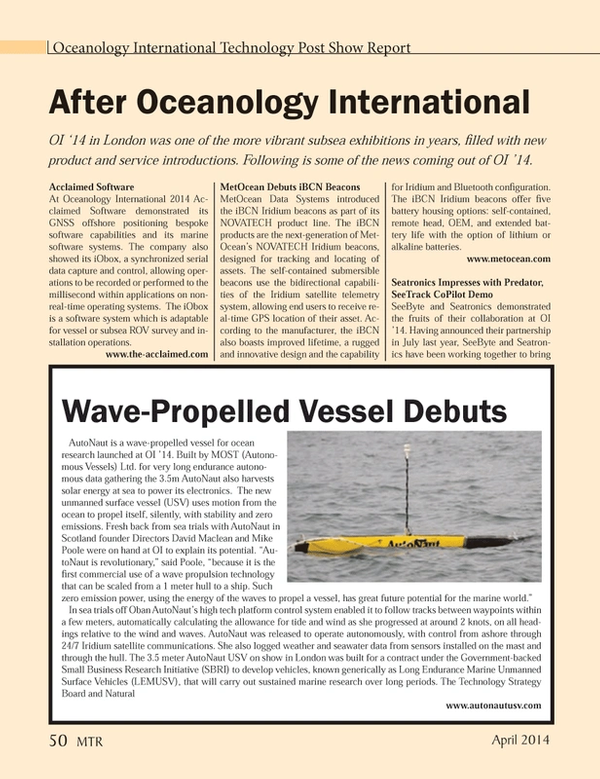
Wave-Propelled Vessel Debuts
AutoNaut is a wave-propelled vessel for ocean research launched at OI ’14. Built by MOST (Autonomous Vessels) Ltd. for very long endurance autonomous data gathering the 3.5m AutoNaut also harvests solar energy at sea to power its electronics. The new unmanned surface vessel (USV) uses motion from the ocean to propel itself, silently, with stability and zero emissions. Fresh back from sea trials with AutoNaut in Scotland founder Directors David Maclean and Mike Poole were on hand at OI to explain its potential. “AutoNaut is revolutionary,” said Poole, “because it is the first commercial use of a wave propulsion technology that can be scaled from a 1 meter hull to a ship. Such zero emission power, using the energy of the waves to propel a vessel, has great future potential for the marine world.”
In sea trials off Oban AutoNaut’s high tech platform control system enabled it to follow tracks between waypoints within a few meters, automatically calculating the allowance for tide and wind as she progressed at around 2 knots, on all headings relative to the wind and waves. AutoNaut was released to operate autonomously, with control from ashore through 24/7 Iridium satellite communications. She also logged weather and seawater data from sensors installed on the mast and through the hull. The 3.5 meter AutoNaut USV on show in London was built for a contract under the Government-backed Small Business Research Initiative (SBRI) to develop vehicles, known generically as Long Endurance Marine Unmanned Surface Vehicles (LEMUSV), that will carry out sustained marine research over long periods.
www.autonautusv.com
Read Wave-Propelled Vessel Debuts in Pdf, Flash or Html5 edition of April 2014 Marine Technology
Other stories from April 2014 issue
Content
- MTR April 2014: Editor's Note page: 6
- Predator II ROV Put through its Paces @ FAU page: 8
- Imenco & High Resolution Subsea Digital Imaging page: 10
- Robotic Marine Vehicles: Meet the Anaconda-2 page: 16
- Upgraded Alvin Sub Passes Scientific Sea Trials page: 20
- STEM: SeaPerch Underwater Robotic Championships page: 24
- Subsea Processing Boosting and Gas Compression page: 28
- Offshore Oil & Gas: Brazil’s Northern Frontier page: 34
- The Future of Arctic Drilling: 90 Billion Barrels & Counting page: 38
- Underwater Laser Scanning for Subsea Pipeline Inspection page: 42
- Wave-Propelled Vessel Debuts page: 50
- Buoy Range Added to the EIVA page: 51
- New Acoustic Release from Teledyne Benthos page: 52
- Sonardyne Debuts SensorView Software page: 52
- Teledyne TSS Launches AHRS and INS Systems page: 53
- New Gyrocompass from Kongsberg page: 53
- FSI Announces new LF Bubble Gun page: 54
- TWR Delivers 6 Slocum Turbulence Gliders page: 54
- Kongsberg Makes Multiple Debuts in London at Oceanology 2014 page: 55
- Product Spotlight: FLEXUS More than an ROTV page: 56
- Insulated Wire Expands page: 57
- Tritech StarFish for Z-Boat 1800 page: 57
- Nautronix to Supply DPR System for Rig page: 57
- Lankhorst Mooring Ropes for Western Isles Development FPSO page: 58
- Seacon Expands Connector Range page: 58
- iXBlue, Septentrio Create ATLANS-C page: 58
- EdgeTech System for Polish Defense AUVs page: 59
- HYPACK Automatic Download of ENC Charts page: 59


